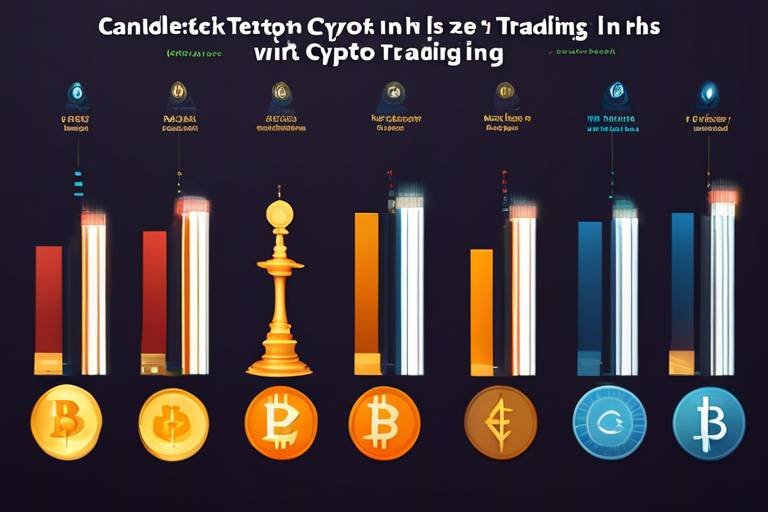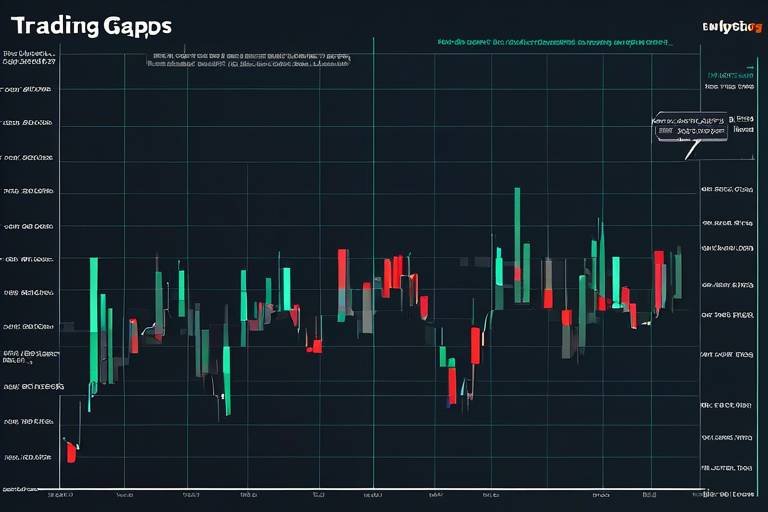The Role of Trend Analysis in Long-Term Crypto Investments
In the fast-paced world of cryptocurrencies, making informed investment decisions can feel like navigating through a dense fog. With prices fluctuating wildly and new coins emerging daily, how do you even begin to chart a course for success? Enter trend analysis, a beacon of light that can guide you through the uncertainty. This method is not just a buzzword; it's a critical tool that helps investors understand past market behaviors to make educated predictions about future movements. By analyzing trends, you can identify potential opportunities and mitigate risks, ultimately leading to more strategic and profitable long-term investments.
But what exactly is trend analysis? At its core, it's about looking at historical price data to discern patterns that might repeat themselves. Think of it as piecing together a puzzle; each price movement is a piece that, when combined with others, reveals a larger picture of market dynamics. In the realm of crypto, where volatility reigns supreme, having a solid grasp of trend analysis can mean the difference between riding the waves of profit and getting swept under by losses.
As you embark on your journey into the world of crypto investments, it's essential to realize that trend analysis is not a crystal ball. Instead, it's a toolkit filled with various indicators and strategies that, when used properly, can enhance your investment decisions. From moving averages to momentum oscillators, each tool offers unique insights that can help you stay ahead of the curve. By the end of this article, you'll not only understand the significance of trend analysis but also how to apply it effectively to your long-term investment strategy.
Trend analysis is a fundamental technique in finance that involves evaluating historical price movements to predict future trends. In the context of the crypto market, this technique is particularly vital due to the extreme volatility that characterizes digital currencies. Unlike traditional markets, where trends can develop over years, crypto trends can shift in a matter of hours or even minutes. This rapid pace demands that investors remain vigilant and informed.
By understanding trend analysis, you can become adept at spotting potential market shifts before they happen. For instance, if you notice a consistent upward trend in a particular cryptocurrency, it might be a signal to invest before the price skyrockets. On the flip side, recognizing a downward trend can prompt you to reconsider your holdings or take protective measures. The key takeaway here is that trend analysis equips you with the foresight needed to navigate this unpredictable landscape.
Identifying the right indicators is crucial for effective trend analysis. There are several metrics that can help you gauge market momentum and make informed decisions. Among the most popular indicators are moving averages, Relative Strength Index (RSI), and Moving Average Convergence Divergence (MACD). Each of these tools provides unique insights into market trends and can be used in conjunction to create a comprehensive analysis.
Moving averages are one of the most widely used indicators in trend analysis. They smooth out price data to help identify trends over specific periods. By averaging price data, moving averages can help filter out the noise of short-term price fluctuations, allowing investors to focus on the underlying trend. There are two primary types of moving averages: Simple Moving Average (SMA) and Exponential Moving Average (EMA).
The Simple Moving Average is calculated by averaging a set number of past prices. For example, a 50-day SMA takes the average of the last 50 days' closing prices. This method is straightforward and provides a clear picture of the market's direction. However, one drawback is that it may lag behind current price movements, making it less responsive to sudden changes.
On the other hand, the Exponential Moving Average gives more weight to recent prices, making it more responsive to new information. This characteristic allows the EMA to capture short-term trends more effectively than the SMA. Investors often use both types of moving averages together to get a more nuanced view of market trends, helping them make better investment decisions.
The Relative Strength Index is a momentum oscillator that measures the speed and change of price movements. It ranges from 0 to 100 and is typically used to identify overbought or oversold conditions in the market. An RSI above 70 may indicate that a cryptocurrency is overbought, while an RSI below 30 may suggest it is oversold. By incorporating RSI into your trend analysis, you can gain valuable insights into potential price reversals.
Implementing trend analysis effectively can lead to more strategic investment decisions. The first step is to set clear investment goals. What are you hoping to achieve through your investments? Are you looking for quick profits, or are you in it for the long haul? Establishing these goals will help you align your analysis results with your personal investment strategies.
Establishing clear investment goals is essential for utilizing trend analysis. Without a defined objective, you may find yourself swayed by market emotions or short-term fluctuations. By setting specific, measurable goals, you can tailor your trend analysis to meet your needs. For instance, if you're aiming for long-term growth, you might focus more on weekly or monthly trends rather than daily price movements.
Effective risk management is crucial in crypto investments. The volatile nature of the market means that prices can swing dramatically in a short period. By using trend analysis, you can set stop-loss orders to protect your investments from significant downturns. Additionally, you can adjust your portfolio based on the trends you observe, ensuring that you're always in a position to capitalize on favorable market conditions.
- What is trend analysis in crypto? Trend analysis is the evaluation of historical price movements to predict future trends in the cryptocurrency market.
- Why is trend analysis important? It helps investors make informed decisions, identify potential opportunities, and manage risks effectively.
- What are the key indicators for trend analysis? Important indicators include moving averages, RSI, and MACD.
- How can I apply trend analysis to my investments? By setting clear investment goals and using indicators to inform your decisions, you can enhance your investment strategy.

Understanding Trend Analysis
Trend analysis is not just a buzzword thrown around in the finance world; it’s a crucial tool for anyone looking to navigate the often-turbulent waters of cryptocurrency investments. Imagine trying to steer a ship through a storm without a compass—confusing, right? Well, trend analysis acts as that compass, guiding investors by evaluating historical price movements to forecast future trends. In the crypto market, where volatility reigns supreme, understanding these trends can mean the difference between making a fortune and losing your shirt.
At its core, trend analysis involves studying price data over time to identify patterns and make informed predictions. Think of it like watching the weather: just as meteorologists analyze past weather conditions to forecast tomorrow's rain, investors analyze past price movements to predict future market behavior. This technique is essential because it helps investors understand whether a cryptocurrency is likely to rise, fall, or remain stable in the coming days, weeks, or even months.
In the cryptocurrency landscape, where new coins and tokens pop up daily, trend analysis becomes even more vital. It allows investors to sift through the noise and focus on what truly matters. By identifying trends, investors can spot opportunities and avoid potential pitfalls. For instance, if a particular cryptocurrency has been consistently rising over a few weeks, it might be a signal to invest before it climbs even higher. Conversely, if a coin has been in a downward spiral, it could be wise to hold off or even sell.
But why is trend analysis so effective in the crypto market? One key reason is the emotional aspect of trading. Many investors make decisions based on fear or greed, leading to erratic price movements. Trend analysis helps to counteract this emotional rollercoaster by providing a more rational framework for decision-making. Instead of reacting impulsively to market fluctuations, investors can rely on data-driven insights to guide their choices.
Moreover, trend analysis is not just about looking at price charts; it also involves understanding the broader market context. This includes factors such as news events, regulatory changes, and technological advancements that can influence cryptocurrency prices. By combining technical analysis with a keen awareness of market dynamics, investors can develop a more comprehensive view of the landscape.
In summary, mastering trend analysis is like learning to read a map in an unfamiliar territory. It equips investors with the knowledge they need to make strategic decisions in the ever-changing world of cryptocurrencies. With the right tools and insights, anyone can navigate this exciting yet challenging market and potentially reap significant rewards.

Key Indicators for Trend Analysis
When it comes to navigating the unpredictable waters of the cryptocurrency market, having the right tools at your disposal can make all the difference. Trend analysis is not just about looking at price charts; it’s about understanding the underlying indicators that can provide insights into market behavior. In this section, we will explore some of the most essential metrics that every investor should consider when performing trend analysis. These indicators include Moving Averages, Relative Strength Index (RSI), and Moving Average Convergence Divergence (MACD). Each of these tools serves a unique purpose in helping you gauge market momentum and make informed investment decisions.
The first key indicator we’ll discuss is the Moving Average. This tool is vital for smoothing out price data over a specified period, which helps to identify the overall direction of the market. By filtering out the 'noise' from random price fluctuations, moving averages allow investors to see the bigger picture. Whether you're a day trader or a long-term investor, understanding how to use both Simple Moving Averages (SMA) and Exponential Moving Averages (EMA) can significantly enhance your trading strategies.
Next up is the Relative Strength Index (RSI), a momentum oscillator that provides insights into whether an asset is overbought or oversold. Imagine it as a compass that tells you when to buy or sell based on the market's momentum. The RSI ranges from 0 to 100, and typically, a reading above 70 indicates overbought conditions, while a reading below 30 suggests oversold conditions. This information can be crucial for timing your trades effectively.
Finally, we have the Moving Average Convergence Divergence (MACD). This indicator is a bit more complex but incredibly powerful. The MACD consists of two moving averages and is used to identify potential buy and sell signals. When the MACD line crosses above the signal line, it may indicate a bullish trend, while a crossover below can suggest a bearish trend. Understanding how to interpret these signals can provide a significant edge in your investment strategy.
In summary, utilizing key indicators such as Moving Averages, RSI, and MACD can provide you with a comprehensive toolkit for trend analysis. Each of these indicators serves a specific function and can be combined to create a more robust investment strategy. As you become more familiar with these tools, you'll find that they can help you make more informed decisions, ultimately leading to better returns on your investments.

Moving Averages
When it comes to navigating the tumultuous waters of the cryptocurrency market, are like a lighthouse guiding your ship safely to shore. They help investors filter out the noise and focus on the underlying trends by smoothing out price data over specific periods. This technique is invaluable, especially in a market as volatile as crypto, where prices can swing wildly in a matter of minutes. Understanding how to utilize both Simple Moving Averages (SMA) and Exponential Moving Averages (EMA) can significantly enhance your investment strategies.
The Simple Moving Average (SMA) is calculated by taking the average of a set number of past prices. For instance, if you were to calculate a 10-day SMA, you would add up the closing prices of the last 10 days and divide that sum by 10. This method provides a clear view of the price trend over time, allowing you to identify support and resistance levels. However, one downside of the SMA is that it can lag behind current price movements, which may cause you to miss out on timely trading opportunities.
On the other hand, the Exponential Moving Average (EMA) addresses this limitation by giving more weight to recent prices. This makes the EMA more responsive to new information, effectively capturing short-term trends that the SMA might overlook. For example, if a cryptocurrency experiences a sudden surge in price, the EMA will adjust more quickly than the SMA, allowing investors to react swiftly. Understanding the differences between these two types of moving averages can help you make more informed decisions tailored to your investment style.
Here’s a quick comparison of the two:
| Feature | Simple Moving Average (SMA) | Exponential Moving Average (EMA) |
|---|---|---|
| Calculation | Average of past prices | Weighted average giving more importance to recent prices |
| Responsiveness | Slower to react | Faster to react |
| Best Use | Long-term trends | Short-term trends |
In practice, many traders use both SMA and EMA in tandem to create a more robust trading strategy. For example, you might use the SMA to identify long-term trends while relying on the EMA for shorter-term entry and exit points. This combination can provide a comprehensive view of market conditions, helping you to make decisions that align with your investment goals.
Ultimately, mastering moving averages is about finding the right balance. Are you looking to ride out the long waves of the market, or do you prefer to catch the quick surges? By understanding how to apply moving averages effectively, you can position yourself for success in the ever-evolving world of cryptocurrency investments.

Simple Moving Average (SMA)
The is one of the most widely used indicators in trend analysis, particularly in the world of cryptocurrencies. At its core, the SMA is calculated by taking the average of a specified number of past prices over a given period. This simple yet powerful tool allows investors to smooth out price fluctuations and identify the underlying trend more clearly. Imagine you're trying to decipher a complex piece of music; the SMA helps you focus on the melody by filtering out the noise.
To calculate the SMA, you simply add up the closing prices of a cryptocurrency for a certain number of days and then divide that sum by the number of days. For example, if you want to calculate a 5-day SMA, you would take the closing prices from the last 5 days, add them together, and divide by 5. Here’s a quick formula to visualize it:
SMA (P1 + P2 + P3 + P4 + P5) / 5
Where P1, P2, P3, P4, and P5 are the closing prices for the last five days. The resulting SMA value can then be plotted on a chart alongside the cryptocurrency's price to provide a clearer picture of the trend.
One of the key advantages of using the SMA is its simplicity. It’s easy to calculate and interpret, making it accessible to both novice and experienced investors. However, while the SMA can help you identify the direction of the trend, it does have its limitations. For instance, because it gives equal weight to all prices in the period, it may lag behind the current price action, especially in a rapidly changing market like crypto. This lag can sometimes lead to missed opportunities or late entries into a trade.
To maximize the effectiveness of the SMA, many investors use it in combination with other indicators. For example, pairing the SMA with the Exponential Moving Average (EMA) can provide a more nuanced view of market trends. The EMA reacts more quickly to price changes, which can help in identifying potential entry and exit points. Here’s a brief comparison of the two:
| Indicator | Weighting | Responsiveness | Use Cases |
|---|---|---|---|
| Simple Moving Average (SMA) | Equal weight | Less responsive | Identifying long-term trends |
| Exponential Moving Average (EMA) | More weight on recent prices | More responsive | Capturing short-term price movements |
In conclusion, the SMA is a fundamental tool in the arsenal of any crypto investor. By providing a clear view of price trends, it helps in making informed decisions. However, it's essential to be aware of its limitations and to use it alongside other indicators for a more comprehensive analysis. After all, investing in cryptocurrencies is not just about following one path; it's about navigating a complex landscape where multiple indicators can guide you to success.

Exponential Moving Average (EMA)
The is a powerful tool that investors often turn to when navigating the choppy waters of the cryptocurrency market. Unlike the Simple Moving Average (SMA), which treats all data points equally, the EMA places a greater emphasis on the most recent prices. This characteristic makes the EMA particularly valuable for those looking to capture short-term trends and react swiftly to market changes. Think of the EMA as a finely tuned radar system, honing in on the latest signals while filtering out the noise of older data.
To calculate the EMA, you need to determine the weighting multiplier, which is based on the number of periods you want to consider. The formula for the weighting multiplier is:
Weighting Multiplier 2 / (N + 1)
Where N is the number of periods. For example, if you're calculating a 10-day EMA, the weighting multiplier would be:
Weighting Multiplier 2 / (10 + 1) 0.1818
Once you have the weighting multiplier, you can use it to smooth out the price data. The EMA is calculated using the following formula:
EMA_today (Price_today * Weighting Multiplier) + (EMA_yesterday * (1 - Weighting Multiplier))
This formula allows the EMA to react more quickly to price changes compared to the SMA, making it an essential indicator for traders who want to capitalize on short-term price movements. For instance, if a cryptocurrency suddenly spikes in value, the EMA will reflect this change almost immediately, while the SMA may lag behind, giving traders a potential advantage.
One of the most appealing aspects of the EMA is its versatility. It can be used in various trading strategies, from identifying potential entry and exit points to confirming trends. Here are a few ways traders often leverage the EMA:
- Trend Confirmation: When the price is above the EMA, it suggests a bullish trend, while a price below the EMA indicates a bearish trend.
- Crossover Signals: Traders often look for crossovers between short-term and long-term EMAs to signal potential buy or sell opportunities. For example, if a short-term EMA crosses above a long-term EMA, it may indicate a buying opportunity.
- Support and Resistance Levels: The EMA can act as a dynamic support or resistance level, providing traders with additional insights into potential price reversals.
In summary, the Exponential Moving Average is more than just a technical indicator; it's a vital part of a trader's toolkit. By understanding how to calculate and interpret the EMA, investors can make more informed decisions in the fast-paced world of cryptocurrency. As you dive deeper into your trading strategies, consider incorporating the EMA to enhance your ability to react to market fluctuations and seize opportunities as they arise.
- What is the main difference between EMA and SMA? The main difference lies in how they weigh price data; EMA gives more weight to recent prices, making it more responsive to new information.
- How can I use EMA in my trading strategy? EMA can be used for trend confirmation, generating crossover signals, and identifying support and resistance levels.
- Is EMA suitable for long-term investments? While EMA is primarily used for short-term trading, it can also provide valuable insights for long-term strategies when combined with other indicators.

Relative Strength Index (RSI)
The is an essential tool for traders and investors in the cryptocurrency market, acting as a momentum oscillator that gauges the speed and change of price movements. Imagine trying to catch a wave while surfing; just like you need to sense the right moment to ride the wave, the RSI helps you identify the right time to enter or exit a trade. The RSI ranges from 0 to 100, providing a clear visual representation of market conditions. Typically, an RSI reading above 70 indicates that a cryptocurrency is overbought, suggesting that it might be due for a price correction. Conversely, an RSI reading below 30 signals that the asset is oversold, which could indicate a potential buying opportunity.
Understanding how to interpret the RSI can significantly enhance your investment strategy. For instance, if you're eyeing a particular cryptocurrency and notice its RSI is hovering around 75, it might be wise to hold off on purchasing until the price stabilizes. On the other hand, if the RSI dips below 30, it might be a golden opportunity to buy low. This oscillating nature of the RSI makes it a powerful ally in navigating the often volatile waters of crypto trading.
Additionally, the RSI can be combined with other indicators to provide a more comprehensive view of market conditions. For example, if the RSI indicates overbought conditions while the price is still climbing, it could be a sign of a strong bullish trend. However, if you notice divergence between the RSI and the price action—like the price reaching new highs while the RSI fails to do the same—this could signal a potential reversal. This divergence is a crucial aspect that many traders overlook, but it can provide valuable insights into the market's strength.
To summarize, the RSI is not just a standalone indicator; it serves as a piece of a larger puzzle. By incorporating it into your trend analysis, you can make more informed decisions regarding your crypto investments. Remember, while the RSI is a powerful tool, it should be used in conjunction with other indicators and personal judgment. After all, investing in cryptocurrencies is not just about numbers; it's about understanding the market's pulse and making strategic moves at the right time.
- What is a good RSI level to buy or sell? Generally, an RSI above 70 indicates an overbought condition, while below 30 indicates oversold. However, context matters!
- Can the RSI be used for all cryptocurrencies? Yes, the RSI can be applied to any cryptocurrency, but the interpretation may vary based on market conditions.
- How often should I check the RSI? It depends on your trading strategy. Day traders might check it multiple times a day, while long-term investors may look at it weekly or monthly.

Applying Trend Analysis to Crypto Investments
When it comes to investing in cryptocurrencies, simply purchasing coins and hoping for the best isn't a viable strategy. Instead, applying trend analysis can transform your approach, allowing you to make informed decisions that can lead to greater returns. By studying price movements and trends, you can uncover valuable insights that guide your investment strategy. But how do you effectively implement trend analysis in the unpredictable world of crypto? Let's dive into some practical steps that will help you navigate this volatile market.
First and foremost, it’s essential to set clear investment goals. What do you want to achieve? Are you looking for short-term gains, or are you in it for the long haul? By establishing specific objectives, you can align your trend analysis with your personal investment strategies. For instance, if you aim for long-term growth, you might focus on identifying broader market trends rather than short-term fluctuations. This clarity not only aids in decision-making but also helps you stay disciplined during market volatility.
Next, consider the importance of risk management strategies. The crypto market is notorious for its wild price swings, making effective risk management crucial. By utilizing trend analysis, you can set stop-loss orders that automatically sell your assets when they drop to a certain price, thereby limiting potential losses. Additionally, you can adjust your portfolio based on trends you observe. For example, if a particular cryptocurrency shows a consistent downward trend, it might be wise to reallocate your funds to more promising assets. This proactive approach can help safeguard your investments against the unpredictable nature of the market.
Furthermore, actively monitoring market trends allows you to stay ahead of the curve. With the right tools and indicators, you can identify patterns that might suggest future price movements. For instance, if you notice that a cryptocurrency consistently rises after a certain moving average is crossed, you can use this information to time your investments more effectively. By remaining vigilant and adapting your strategy based on ongoing trend analysis, you can position yourself for success in an ever-changing landscape.
In conclusion, applying trend analysis to your crypto investments is not just about crunching numbers; it's about developing a comprehensive strategy that considers your goals and risk tolerance. By setting clear objectives and employing sound risk management techniques, you can leverage trend analysis to make informed decisions that maximize your returns while minimizing risks. Remember, the key to success in the crypto market lies in your ability to adapt and respond to the trends you observe.
- What is trend analysis? Trend analysis is a technique used to evaluate historical price movements to predict future trends in the market.
- How can I set investment goals? Start by determining what you want to achieve with your investments, whether it's short-term gains or long-term growth, and align your strategy accordingly.
- What are stop-loss orders? A stop-loss order is a risk management tool that automatically sells your asset when it reaches a certain price to limit potential losses.
- How do I identify market trends? You can identify market trends by analyzing various indicators, such as moving averages and the Relative Strength Index (RSI).

Setting Investment Goals
When diving into the world of cryptocurrency, setting clear investment goals is akin to charting a course before embarking on a journey. Without a destination in mind, you might find yourself wandering aimlessly, potentially missing out on lucrative opportunities. So, what exactly should these goals entail? First and foremost, they should reflect your financial aspirations and risk tolerance. Are you aiming for short-term gains to fund a vacation, or are you in it for the long haul, looking to build a retirement nest egg? Understanding your objectives can significantly influence your approach to trend analysis.
Moreover, it’s essential to align your investment goals with your personal circumstances. For instance, if you have a steady income and can afford to take risks, you might set aggressive targets. Conversely, if you’re nearing retirement, a more conservative approach might be prudent. This alignment not only helps in crafting a tailored investment strategy but also serves as a motivational tool, pushing you to stay committed during market fluctuations.
Another critical aspect of goal-setting is the timeframe. Are you looking at a short-term, medium-term, or long-term investment horizon? Each timeframe comes with its own set of strategies and considerations. For example, short-term traders might focus on daily price movements and technical indicators, while long-term investors could prioritize fundamental analysis and broader market trends. To illustrate this further, here’s a simple table that outlines different investment horizons:
| Investment Horizon | Focus | Typical Strategies |
|---|---|---|
| Short-Term | Quick gains | Day trading, scalping |
| Medium-Term | Moderate growth | Swing trading, trend following |
| Long-Term | Wealth accumulation | Buy and hold, dollar-cost averaging |
Finally, it’s crucial to revisit and, if necessary, revise your goals regularly. The crypto market is notoriously volatile, and what seemed like a sound strategy a few months ago may not hold water today. By keeping your goals flexible and adaptable, you can respond more effectively to market trends and external economic factors. So, take a moment to reflect on your investment goals—are they realistic? Are they measurable? And most importantly, are they aligned with your overall financial strategy? By answering these questions, you can set yourself up for a more successful investment journey in the unpredictable world of cryptocurrencies.
- What are the most important factors to consider when setting investment goals? When setting investment goals, consider your financial situation, risk tolerance, investment timeframe, and personal aspirations.
- How often should I review my investment goals? It's advisable to review your investment goals at least annually, or whenever there are significant changes in your financial situation or the market.
- Can I change my investment goals over time? Absolutely! As your financial situation and market conditions evolve, it's important to adjust your investment goals accordingly.

Risk Management Strategies
When it comes to investing in cryptocurrencies, understanding and implementing is not just an option; it's a necessity. The crypto market is notorious for its volatility, where prices can skyrocket one moment and plummet the next. This unpredictability can be daunting, but with the right strategies in place, you can safeguard your investments and minimize potential losses. So, how do you navigate this turbulent landscape? Let's dive in!
One of the most effective risk management strategies is setting stop-loss orders. A stop-loss order is a predetermined price at which you will sell an asset to prevent further losses. For example, if you purchase a cryptocurrency at $100 and set a stop-loss at $90, your investment will automatically sell if the price drops to that level. This strategy ensures that you cut your losses before they escalate, allowing you to maintain a healthier portfolio.
Another crucial aspect of risk management is diversification. Just like in traditional investing, putting all your eggs in one basket can be risky. In the crypto world, this means investing in a variety of cryptocurrencies rather than concentrating all your funds into one. By diversifying, you can balance the risks associated with each asset. If one cryptocurrency takes a hit, others in your portfolio may still perform well, cushioning the blow. Think of it as a safety net that can help you weather the storm.
Additionally, you should regularly reassess your portfolio. The crypto market is dynamic, and what works today may not work tomorrow. By keeping an eye on market trends and adjusting your holdings accordingly, you can optimize your investment strategy. This might involve selling off assets that are underperforming or reallocating funds to cryptocurrencies that show potential for growth. Essentially, staying informed and adaptable is key.
Moreover, consider employing position sizing as a risk management technique. This involves determining how much of your total capital you are willing to risk on a single trade. A common rule of thumb is to risk no more than 1-2% of your total capital on a single investment. This way, even if several trades go against you, you still have enough capital left to recover and continue investing.
Finally, emotional discipline is a critical component of risk management. Fear and greed are powerful emotions that can lead to poor decision-making. It's essential to stick to your investment strategy and not let emotions dictate your actions. Consider setting predefined rules for entering and exiting trades, and adhere to them, regardless of the market's fluctuations. This disciplined approach can help you avoid the pitfalls that many investors fall into during volatile periods.
In summary, effective risk management strategies in cryptocurrency investments include:
- Setting stop-loss orders to limit potential losses
- Diversifying your portfolio to spread risk
- Regularly reassessing your investments to stay aligned with market trends
- Utilizing position sizing to manage how much capital you risk on each trade
- Maintaining emotional discipline to avoid impulsive decisions
By implementing these strategies, you can better navigate the unpredictable waters of the crypto market and enhance your chances of achieving long-term success.
Q: What is the most important risk management strategy for crypto investors?
A: While all strategies are important, setting stop-loss orders is often considered the most critical, as it helps limit potential losses automatically.
Q: How can I diversify my crypto portfolio?
A: You can diversify by investing in a mix of cryptocurrencies across different sectors, such as DeFi, NFTs, and stablecoins, rather than putting all your funds into one coin.
Q: What is position sizing and why is it important?
A: Position sizing refers to determining the amount of capital to risk on a single trade. It's important because it helps protect your overall portfolio from significant losses.
Q: How often should I reassess my crypto investments?
A: It's advisable to reassess your investments regularly, at least every few weeks or whenever there are significant market changes, to ensure your strategy remains effective.
Frequently Asked Questions
- What is trend analysis in cryptocurrency investments?
Trend analysis is a technique used to evaluate historical price movements in the crypto market to predict future trends. By analyzing patterns, investors can make informed decisions about when to buy or sell cryptocurrencies, ultimately aiming to maximize returns and minimize risks.
- Why are moving averages important for trend analysis?
Moving averages are crucial because they help smooth out price data, making it easier to identify trends over specific periods. By using both Simple Moving Averages (SMA) and Exponential Moving Averages (EMA), investors can gain insights into market momentum and potential entry or exit points for their investments.
- How does the Relative Strength Index (RSI) work?
The Relative Strength Index (RSI) is a momentum oscillator that measures the speed and change of price movements. It ranges from 0 to 100 and helps investors identify overbought or oversold conditions. Typically, an RSI above 70 indicates an overbought condition, while an RSI below 30 suggests an oversold condition, guiding investment decisions.
- What are some effective risk management strategies in crypto investments?
Effective risk management strategies include setting stop-loss orders, diversifying your portfolio, and regularly reviewing your investment goals. By applying trend analysis, investors can determine optimal stop-loss levels and adjust their strategies based on market conditions, helping to protect their capital.
- How can I set clear investment goals?
Setting clear investment goals involves defining your financial objectives, risk tolerance, and time horizon. Consider what you want to achieve with your investments, whether it's short-term gains or long-term wealth accumulation. Aligning these goals with your trend analysis results can help ensure you make strategic decisions that fit your overall investment strategy.



















